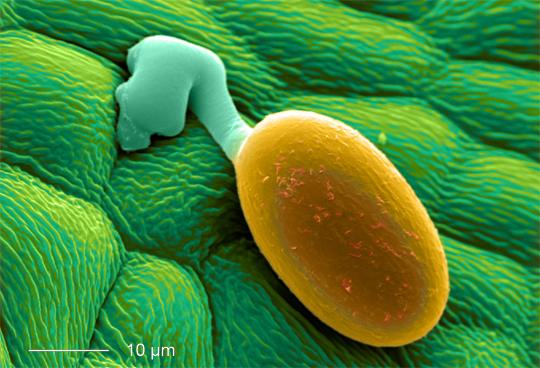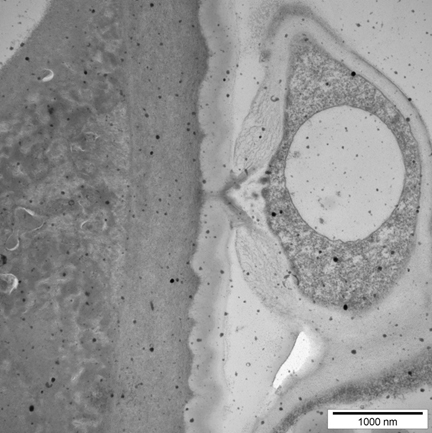The Resistance of the Vine
Freiburg, Mar 06, 2020
A University of Freiburg biologist, Prof. Dr. Hanns-Heinz Kassemeyer, studies diseases of grape vines grown to produce wine. His works provide insight into the infectious mechanism of pathogens that can infest the vines – powdery mildew (Unicinula necator) and downy mildew or (Plasmopara viticola). They also present sustainable methods to protect the vines from these diseases.

Intruder: A germinating powdery mildew spore infests a grape vine. Photo: Nano Imaging Lab of the University of Basel, Staatliches Weinbauinstitut Freiburg
In the tri-national research project "Vitifutur – Nachhaltiger Weinbau am Oberrhein" (Vitifutur – Sustainable Winegrowing on the Upper Rhine) Hanns-Heinz Kassemeyer worked with colleagues from the University of Basel's Nano Imaging Lab on imaging methods. These made visible what happens when a vine or its strain is stricken. The images show how the spores infest the leaves as well as how the plant reacts. Wild species of grape vine are able to muster a rescue response to the infestation. They selectively allow the leaves around the one infested with the pathogen to die, denying the intruder the nutrition it needs to stay alive. This type of plant behavior is called resistance.
Classic, widespread, and popular grape varieties in the Upper Rhine region are pinot gris – grauburgunder – or pinot noir, also known as spätburgunder. Yet these varieties are only minimally resistant to powdery and downy mildew. Vintners then need to respond rapidly to ward off infestation by using conventional types of chemical pesticides. Breeding hybrids of these traditional varieties of grape with wild varieties, however, has produced a new type of vine that is resistant to both diseases. These are known as PIWIs or fungus-resistant grape varieties. They have unusual names that are unfamiliar to the wine-drinking community such as solaris, regent or cabernet carbon.
Resistance rather than pesticides
"Vintners who rely on PIWIs reduce their pesticide use by as much as 75 percent," explains Kassemeyer. "Growing wine and environmental protection do not necessarily have to be mutually exclusive," he adds. With that statement Kassemeyer has entered into the current debate between environmentalists on one side and wine growers on the other. The growers defend themselves against strict standards for pesticide use because they believe these threaten their livelihoods. The researcher is convinced that even the remaining 25 percent need for chemical agents could be reduced. Says Kassemeyer, "A research emphasis of 'Vitifutur' are varieties of grapes that combine the different resistance strategies of the original varieties." As a result, you end up with vines that combine resistance mechanisms that establish several barriers to both diseases.

The new cabernet cantor variety demonstrates a high level of resistance to powdery and downy mildew. Photo: Staatliches Weinbauinstitut Freiburg
In addition to examining the pathogens that can infest a grape vine and breeding resistant grape varieties, there is a third approach to reduce the use of chemical pesticides: Computer-supported predictive systems that vintners can use to help them monitor the course and recognize the threat of an epidemic of powdery and downy mildew. "If we know, for example, that ten wet days in a row are coming, during which it will get colder at the same time, then the development of the pathogens is delayed or inhibited," explains the University of Freiburg biologist. Fungal pathogens have little affinity to either cold or prolonged dry weather. In those conditions they die off. Yet if the temperature goes up during a wet period, "the fungal pressure increases." That's when it's time to selectively use chemical anti-fungal agents.
Triple benefits
"Thanks to intensive research, now we know more about the pathogens for vine diseases and conditions that promote their growth," summarizes Kassemeyer. "We're breeding resistant varieties and working on more precise prognoses. We're making tools available in order to have the use of pesticides approach zero," he says. That's beneficial in several ways. The environment profits, because the anti-fungal agents often damage good insects as well as the disease pathogens. The vintners benefit, because they save money and hours of labor because they don't need to take the tractor out into the vineyard as often. Because they're driving less on the soil, that leads to less compaction, which helps the soil structure and the life in it. And the more diverse the microbiology of the soil, the higher will be the quality of the grapes that are growing on it.
And finally, last but not least, the conflict between agricultural and nature conservation interests is eased, meaning the whole social climate improves as a result. According to Kassemeyer, among the key functions the Vitifutur Final Symposium ("Vitifutur-Abschluss-Symposium") held at the end of October 2019, was to show the public how much scientific research contributes to the general good. He points out, "Unfortunately, that knowledge is no longer a given in this time of general mistrust."

Immune reaction of a grape vine: The cell wall thickens at the point of entry of powdery mildew. Photo: Staatliches Weinbauinstitut Freiburg
The symposium was intended to address vintners directly as well. "There are still many people in our region who rely on the classic varieties," says Kassemeyer. That's why it was good, he says, to have Thomas Schaffner, a vintner from Bötzingen, as a symposium guest. Schaffner is raising the new resistant varieties alongside the classic types of grape. Kassemeyer says the vintner was able to convince his colleagues who attended about the advantages of the resistant varieties. He addressed palatability, too, as was demonstrated in a subsequent tasting – because it won't help anyone if the new varieties are marvelously resistant to disease but fail to please wine-lovers' palates. "Here at the State Viticultural Institute in Freiburg ("Staatlichen Weinbauinstitut Freiburg") we're working in cooperation with our oenologists," says Kassemeyer. Only after they've given it a green light does a new hybrid variety come onto the market.
PIWIs have long since become a niche product in terms of sales. And that niche is growing. In the meantime, varieties such as regent can be found in the supermarket or on wine lists at restaurants. Kassemeyer is also able to report, "They're using PIWIs in Alsace in the meantime – and if a wine-drinking country like France takes these varieties seriously – that's a very good sign."
Mathias Heybrock
Vitifutur – Sustainable Viticulture on the Upper Rhine
The INTERREG V program supported the tri-national research project Vitifutur – Sustainable Viticulture on the Upper Rhine ("Vitifutur – Nachhaltiger Weinbau am Oberrhein") with a total of four million euros. In Freiburg, the University of Freiburg's Institute of Biology II as well as the state viticultural institute took part. Other partners were the Karlsruhe Institute of Technology (KIT), the University of Strasbourg, and the "Institut National de la Recherche Agronomique" in Colmar. The Nano Imaging Lab at the University of Basel in Switzerland contributed to the work as well. A major symposium was held to wrap up the project in October 2019.
www.vitifutur.net

